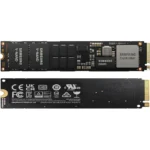Product Overview of the Samsung MZVL21T0HCLR-00B00 1TB PCI-E SSD
The Samsung MZVL21T0HCLR-00B00, a 1 Terabyte (TB) Triple Level Cell (TLC) Peripheral Component Interconnect Express (PCI-E) 4.0 x4 Non-Volatile Memory Express (NVMe) Internal M.2 2280 Solid State Drive (SSD). This impressive piece of hardware packs a punch in terms of storage, speed, and efficiency. Solid State Drives (SSDs) have become increasingly popular due to their faster performance and reliability compared to traditional Hard Disk Drives (HDDs). One such SSD that has gained attention is the Samsung MZVL21T0HCLR-00B00, a 1TB Triple-Level Cell (TLC) NVMe M.2 SSD.
Understanding the Samsung MZVL21T0HCLR-00B00 SSD
Before delving into the specifics, let’s break down the name and various technical terms associated with the Samsung MZVL21T0HCLR-00B00 SSD.
Samsung is a well-known South Korean multinational conglomerate that has a significant presence in the technology industry. They are known for producing a wide range of electronic products, including smartphones, televisions, appliances, and, of course, solid-state drives.
The name “MZVL21T0HCLR-00B00” is a product identifier or model number specific to this particular SSD. It may not provide much information about the drive itself, but it helps users and manufacturers identify and differentiate it from other products in Samsung’s SSD lineup.
1 Terabyte (TB)
This refers to the storage capacity of the SSD. 1 terabyte is equal to 1,000 gigabytes (GB), which means you can store a vast amount of data, including documents, photos, videos, and software, on this drive.
Triple Level Cell (TLC)
TLC is a type of NAND flash memory technology used in solid-state drives. It is named a “triple-level cell” because each memory cell can store three bits of data. This allows for higher data density and lower production costs compared to other NAND technologies like Single Level Cell (SLC) and Multi-Level Cell (MLC).
Peripheral Component Interconnect Express (PCI-E)
PCI-E, or PCIe, is a high-speed interface used for connecting various hardware components inside a computer. In the context of an SSD, it specifies the type of slot or connection that the drive uses to communicate with the motherboard.
4.0 x4
The “4.0” indicates the generation of PCIe technology. PCIe 4.0 is the fourth iteration of this standard, known for its increased data transfer speeds compared to its predecessors. The “x4” specifies the number of lanes used for data transfer. In this case, there are four lanes, which allows for even faster data throughput.
Non-Volatile Memory Express (NVMe)
NVMe is a protocol designed for efficiently accessing and managing data on SSDs. It is built from the ground up to work with solid-state drives, taking full advantage of their speed and low latency. This protocol ensures that the drive operates at its highest potential performance.
Internal M.2 2280
This describes the physical form factor of the SSD. An M.2 drive is a small, rectangular storage device that plugs directly into the motherboard. “2280” indicates the dimensions of the drive, where “22” refers to the width in millimeters, and “80” signifies the length. This form factor is common in modern laptops and desktop computers.



